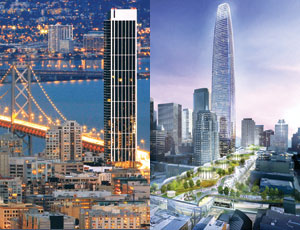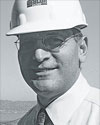Ron Klemencic, who at 6 ft, 6 in., towers over most people, may be afraid of heights but he certainly goes to great lengths to reach new ones, especially when it involves performance-based seismic design of tall buildings. It’s taken Klemencic and his team at Magnusson Klemencic Associates Inc. a dozen years to pry open the floodgates for this type of sophisticated earthquake engineering. That’s in part because there are no guidelines for PSD, which Klemencic calls “real” engineering, in U.S. codes.

At first, the seismic design community resisted PSD. Some “thought we were breaking the rules because we weren’t following the language of the code,” says Klemencic, president of the Seattle-based firm. Others feared, and still do, “that those unqualified will attempt this,” he says.
The approach is a way to meet the intent of the code’s prescriptive, or cookbook, provision for buildings taller than 240 ft that mandate a dual frame to resist lateral loads. Dual systems typically have a shear-wall core and a heavy perimeter moment frame. Architects don’t like them because they limit expression.
PSDs contain a single, less costly and faster-to-build coreonly framing system to resist lateral loads. Single frames, by contrast, allow any type of building skin, including floor-to-ceiling windows, because there are no spandrel beams, says Clark Manus, CEO of Heller Manus Architects, San Francisco.
Manus was the architect on the 350-ft-tall Infinity, MKA's first PSD tower in San Francisco, which opened in late 2007. He says that thanks to Klemencic’s tenacity during Infinity’s arduous and protracted approval process, which they both characterize as an “ordeal,” PSD will soon be “the only system used for a high-rise residential tower” in a high seismic zone.

Klemencic waged a 12- year crusade to gain acceptance for what he calls “real” seismic engineering for tall buildings in the U.S.
Infinity paved the way for MKA’s second PSD tower in San Francisco and the tallest in the U.S., the 590-ft One Rincon Hill, developed by Urban West Associates, San Diego, which opened last year. The use of PSD on One Rincon Hill “enabled the architecture...to be unique to the city,” says Peter Noone, principal in the Chicago office of the architect, Solomon Cordwell Buenz.
The early controversy made the first PSD developers wary of publicity. “But after we completed a few projects and won approval for a few more, the original reaction among engineers changed,” says Klemencic. Urban West even made PSD part of its successful One Rincon Hill marketing campaign.
MKA didn’t invent PSD; it was initially developed for seismic retrofits. But the firm was the first to apply it to tall building design, on a tower in Bellevue, Wash. The approach provides the most benefit for high-rises, but it can be used for any type of building, any occupancy or any structure—concrete, steel or hybrid, says Klemencic.
To aid engineers, seismic design groups are writing a guideline for PSD, due out this summer. Klemencic, one of nine primary authors, says it will be the best of several guides published in the past couple years.
In the U.S., there are more than 25 PSDs done, approved or in the works. Many are MKA jobs, but there are at least five other firms doing tall-building PSD.
The engineer intends to increase his number of PSDs by at least one, with his so-called “career project.” In the fall, MKA was awarded San Francisco’s planned, 1,000-ft-tall Transbay Tower, on deck to be the tallest skyscraper in the U.S. west of Chicago and the tallest in the U.S. in a high seismic zone.


Post a comment to this article
Report Abusive Comment